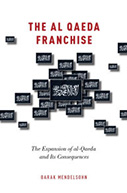The al-Qaeda Franchise: The Expansion of al-Qaeda and Its Consequences

Author: Barak Mendelsohn
Publisher: New York; Oxford, UK: Oxford University Press, 2016. 288p.
Reviewer: Isaac Kfir | September 2016
In The al-Qaeda Franchise, Barak Mendelsohn offers an interesting view of al-Qaeda’s strategy over the last decade, specifically what he describes as its franchising strategy. The book, with a rather ambitious thesis, assesses how this franchising strategy impacted the organization and in doing so makes some suggestions to policymakers as to how they should devise a counterterrorism strategy. In making this argument, Mendelsohn seeks to show that the franchising strategy has not made al-Qaeda more dangerous nor stronger, but rather has weakened it, as it has had to adapt to local conditions and demands.
The book has two principal sections. The first, which is far more interesting, lays out the theoretical framework, whereas the second part chapters 6-9, provides case studies to support Mendelsohn’s theoretical exposition.
The author’s theoretical framework is effectively a typology of formal organizational expansion, where he distinguishes between absorption, branching out, unification, and umbrella groups (each is given its own chapter later on in the book, though the main focus of the book is with the branching out strategy). These approaches to expansion are distinct, and although there may be some overlap, by his focusing on the type of expansion, insight emerges as to the objective of the organization and the threat they pose. Such an approach could be enormously useful for policymakers as they struggle with various counterterrorism policies.
In discussing the various expansion strategies, Mendelsohn correctly asserts that organizational expansion operates at a higher level than operational adaptation in that the former demands a willingness to accept structural changes, whereas the latter focuses mainly on tactics. In laying out this basic premise, Mendelsohn provides support to those who argue that al-Qaeda’s ideology is not merely theological, emphasizing a need for strict adherence, but rather is flexible. Put differently, instead of seeing al-Qaeda as an uncompromising, dogmatic terror group, Mendelsohn sees it as a rational actor, committed to expanding its influence even if it is at the cost of its theological cohesion.
To understand the expansion strategy, particularly when it comes to branching out, there is a need to consider what Mendelsohn calls the actors-based perspective and the arena-based perspective. The former essentially refers to psychological elements that impact upon the group and its leaders. The latter has three considerations. First, ideational values. This means that an arena becomes attractive to a group not only because of religious or historical aspects, but also for ideological reasons. Thus, Saudi Arabia, Iraq or Palestine, for instance, are attractive to a group such as al-Qaeda, as each combines all three elements: religion, history and ideology. That is, these locals have religious, historical and ideological values for existing and having potential recruits. The second consideration is a strategic value, which is when an organization identifies certain fronts as being vital for its overall mission success. In the case of al-Qaeda, its strategic area of choice was the Middle East, as noted by al-Zawahiri in 2001 when he called for the organization to establish a base in the Middle East. Oddly enough though, al-Qaeda has not been very successful in this region; as seen for example with its failure to establish a base in Saudi Arabia or Palestine. The third consideration is internal characteristics, because when one introduces new actors into a group, the group naturally changes.
The next chapters analyze the franchising strategy. The first attempt was in Saudi Arabia, with the founding of an al-Qaeda branch in the Kingdom (al-Qaeda in the Arabian Peninsula) and the merger with Abu Musab al-Zarqawi’s group, Jama’at al-Tawhid wal-Jihad (TWJ, Organization of Monotheism and Jihad), which operated in Iraq following the U.S. invasion. Mendelsohn’s argument is that although in 2003 and 2004 when policymakers looked at al-Qaeda’s operation in Saudi Arabia and Iraq and saw an organization they thought was strong, in fact it was far from that. The al-Qaeda branch in Saudi Arabia had suffered devastating losses mainly because of the counteroffensive policies of the Saudi regime. This not only claimed the lives of al-Qaeda recruits, but forced the regime to take a proactive stance against the organization.
Concomitantly, the merger with TWJ was even more fateful because of Zarqawi’s fixation with sectarianism and often counter-productive violent measures, that eventually led to a chastisement by Zawahiri. In Chapter seven, Mendelsohn looks at al-Qaeda’s franchising strategies in Algeria (2006), Yemen (2007), and, Somalia (2010). These cases exemplify the considerations that al-Qaeda went through, as it branched out into these areas. The Yemeni expansion (al-Qaeda in the Arabian Peninsula (AQAP)) was the most successful, not only because the branch supported core al-Qaeda’s global jihadi strategy, but it could also claim responsibility for the killing of the soldiers at Fort Hood, Texas. The Algeria merger came about because of a request from the Algerian Islamists who were in dire straits because of the local counterterrorism policies, which meant that the al-Qaeda leadership had more pull over the group. When it comes to al-Shabaab and Somalia, Mendelsohn accepts that at this stage it is too soon to tell whether the merger was productive, especially as al-Qaeda is still coming to terms with bin Laden’s death.
Chapter eight examines the failure of al-Qaeda in Palestine, where the organization has not sought ties with Hamas — opting to criticize Hamas for engaging in politics (although the real reason was al-Qaeda’s inability to compete with the Muslim Brotherhood in this arena) and its failures in Egypt — and specifically with Gama’a Islamiya which rejected the claim that it had merged with al-Qaeda. Chapter nine then discusses the tensions between al-Qaeda and the Islamic State in Syria. Mendelsohn concludes that when it comes to ISIS, that group not only rejected a merger, it turned against al-Qaeda and became a major competitor to al-Qaeda.
The thesis put forth by Mendelsohn in The al-Qaeda Franchise has a number of shortcomings. First, his argument appears rather deductive, in that a number of assumptions are made, particularly about al-Qaeda’s overall strategy, without really analyzing the strategy or its evolution. It would have strengthened his argument to devote a chapter to assessing al-Qaeda’s theological, political and military goals prior to 9/11, and following the Battle of Tora Bora and the ensuing U.S. led campaign to kill and capture members of al-Qaeda. The need for such an assessment stems from this principal question: what is al-Qaeda’s goal? Is it to destroy the Far Enemy in the hope that this would weaken the current Arab regimes, many of whom rely on the United States? Or, is the goal to bring down a superpower? Or, establish the Caliphate? Or, something else? These questions demand answers, as they help assess the reasons behind why an organization would seek out new members, allies, or groups which may weaken its internal cohesion. Additionally, there is an assumption that al-Qaeda’s goals have remained static, which raises some questions especially because of roles played by such individuals as Younis Tsouli (a.k.a. Irhabi007), who disseminate jihadi literature and information on the internet. Simply, there is the argument that al-Qaeda is no longer an organization, but rather an ideology or even a social movement, which means that it is less focused on having members, and more on spreading its interpretation of Islam. Secondly, clearly there is a dearth of primary resources, and one should not have expected the author to have interviewed al-Qaeda members as to their strategy, but at times his statements and claims demand more concrete as opposed to circumstantial evidence. Third, the case studies, as fascinating as they are, lack depth, particularly the work on the Islamic State — and not only the schism between al-Baghdadi and Zawahiri — but the fact that the Islamic State has attracted thousands to its ranks by not only promising jihadi ideology, but material gains (it pays salaries) and a carte blanche when it comes to violence. Simply, the Islamic State is arguably the latest manifestation of the al-Qaeda brand in that it emerged out of the work and inspiration of Abu Musab al-Zarqawi and Camp Bucca, a detention facility created by the United States in Umm Qasr, Iraq which ended up as the holding area for many of the future leaders of the Islamic State. A fourth question that Mendelsohn never really addresses is whether al-Qaeda is truly a threat. One has to wonder whether the organization which lost its inspirational leader on May 2, 2011, killed in Abbottabad by a U.S. Navy Seal team, is really a threat — as by all indications the groups lacks money and manpower and its recruits are being hounded across the globe.
In sum, Barak Mendelsohn is to be commended for offering an innovative approach to studying al-Qaeda and its purported commitment to expanding its influence. One hopes that Mendelsohn continues to develop his theoretical perspective regarding franchising and terror groups, particularly in reference to the Islamic State, which currently seems to find support across the Middle East, North Africa, and East Africa.
Isaac Kfir, Research Associate, Institute for National Security and Counterterrorism (INSCT)
Syracuse University, NY, USA


